Come and try my small Czech kolacky cookies made from flaky cream cheese dough! Filled with jam and dusted with icing sugar, they melt on your tongue the moment you put them in your mouth.
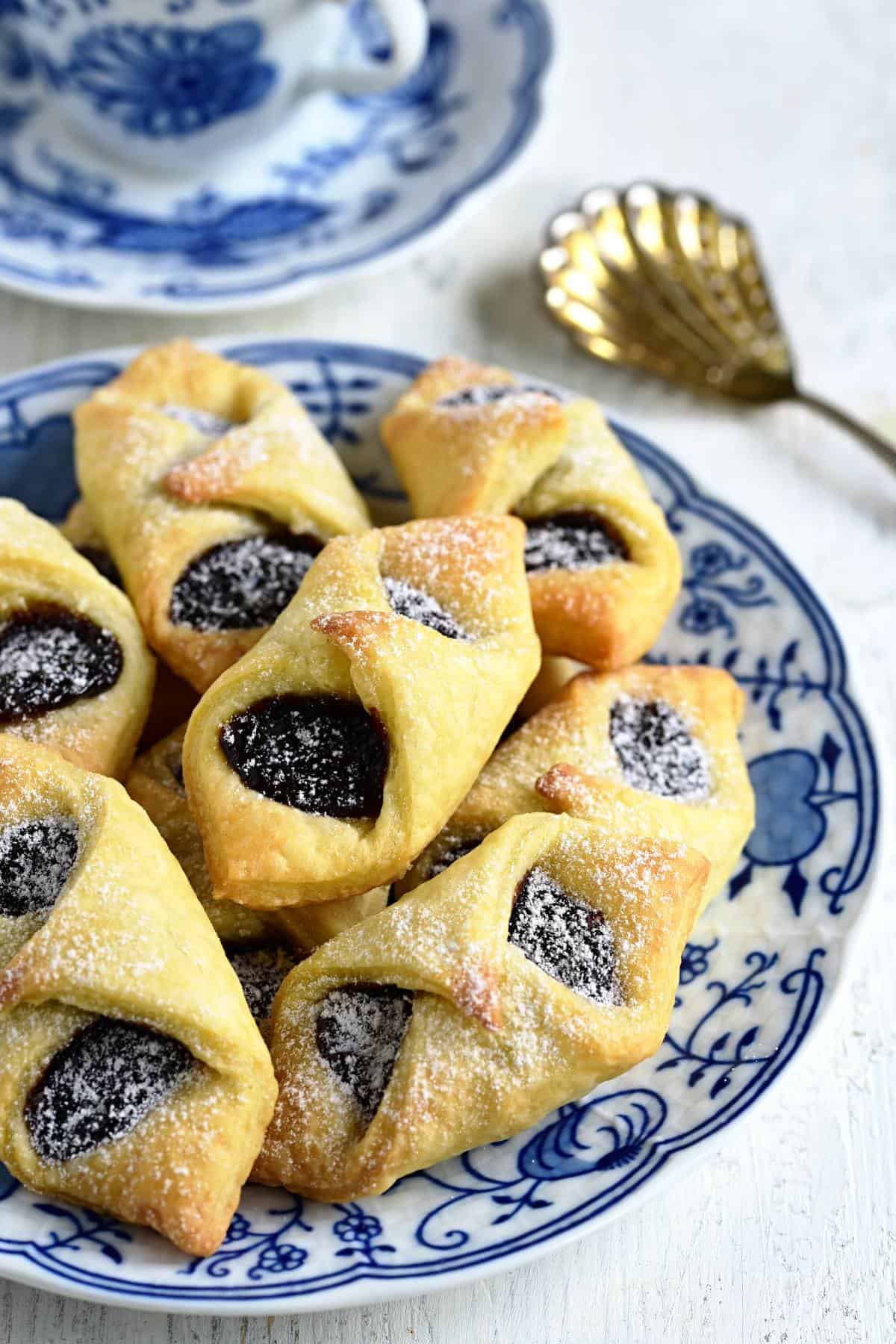
What Is Kolacky?
Kolacky is an original Czech name for small, bite-sized sweet pastries with different kinds of filling. The most common filling is jam, poppy seed, or nut filling. Fresh cream cheese (called tvaroh in Czech) or yeast dough is usually used to make kolacky cookies.
The best thing? This recipe uses fresh cream cheese dough that is very easy to make. You only need three ingredients: unsalted butter, flour, and cream cheese.
Spelling
In Czech, the word kolacky is correctly spelled "koláčky". It is a diminutive of the word kolache (koláče), a well-known Czech pastry.
The word koláčky is plural, i. e. 2 and more pieces. The singular (one piece) of the word is koláček.
Curious how to pronounce the word koláčky? Listen to the short audio clip I recorded. You will hear the Czech pronunciation of the word koláčky (I am a native Czech).
In the Anglo-Saxon world, people also know kolacky as kolachy cookies, kolachys, kolachkey or in Polish as kolaczki.
Ingredients
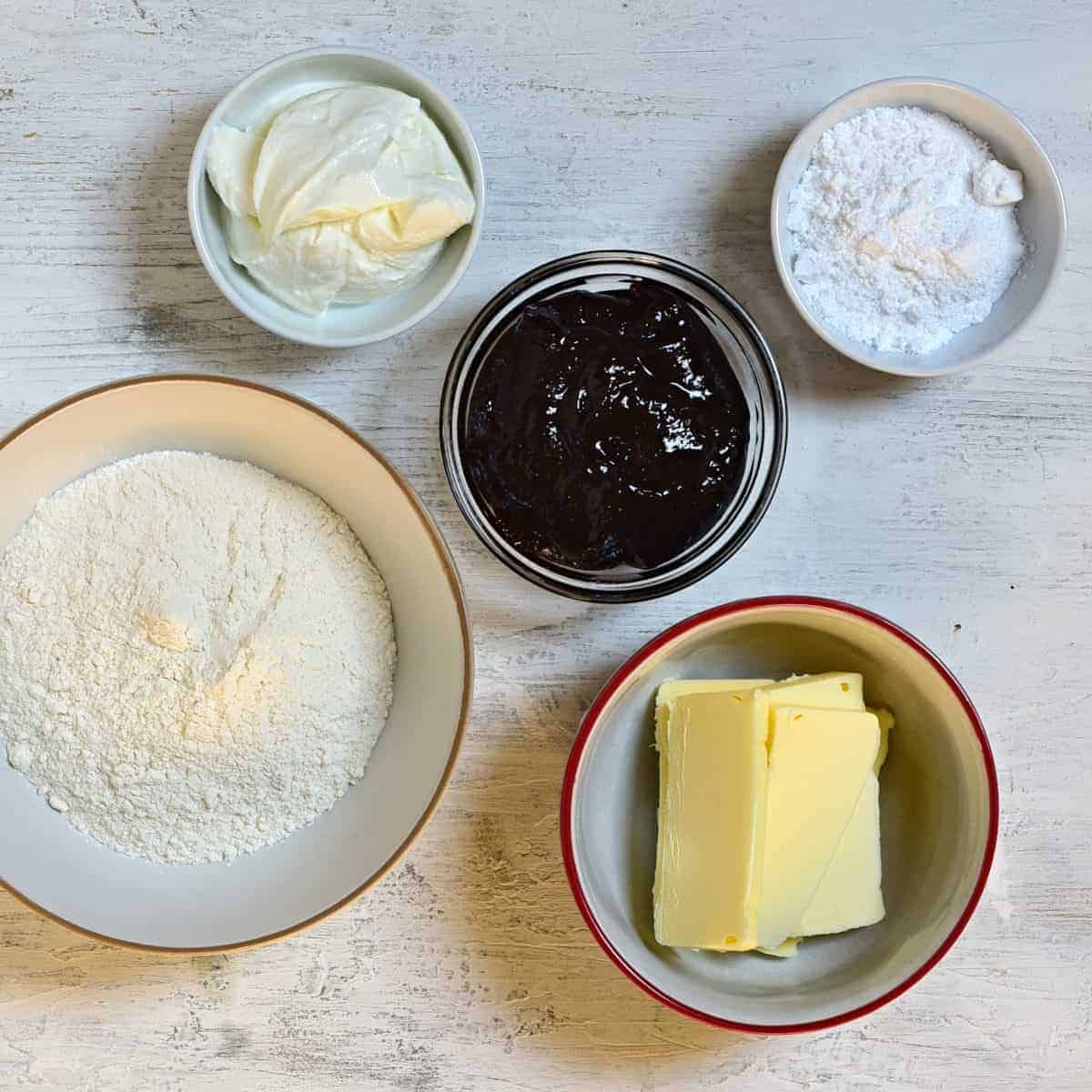
Cream cheese dough:
- Unsalted butter; softened at room temperature
- Cream cheese; at room temperature. Authentic Czech recipe calls for "tvaroh" (a kind of fresh cream cheese), but any flavor-neutral cream cheese will also work well. Czech tvaroh is sometimes substituted for farmer's cheese in the US, but it is quite dry, so I would instead go with classic cream cheese in the case of this recipe.
- All-purpose flour; the exact amount of flour added to the dough will depend on the liquid content in the cream cheese
Kolacky filling
- Jam; use any thick jam or pastry fruit filling. My choice was plum butter (in Czech povidla or in Slovak lekvar), a traditional Czech fruit filling for sweet pastries.
Next, you'll need powdered sugar to dust the baked kolacky cookies.
✅ You’ll find the exact amount of ingredients below in the recipe card, which you can also print out.
Instructions
STEP 1: Take the butter and cream cheese out of the refrigerator in time for them to come to room temperature.
STEP 2: Put the butter, cream cheese, and flour in a larger bowl. Start mixing the ingredients with a fork first. Only when the dough has come together in a homogeneous mass, knead the dough to smoothness with your hands.
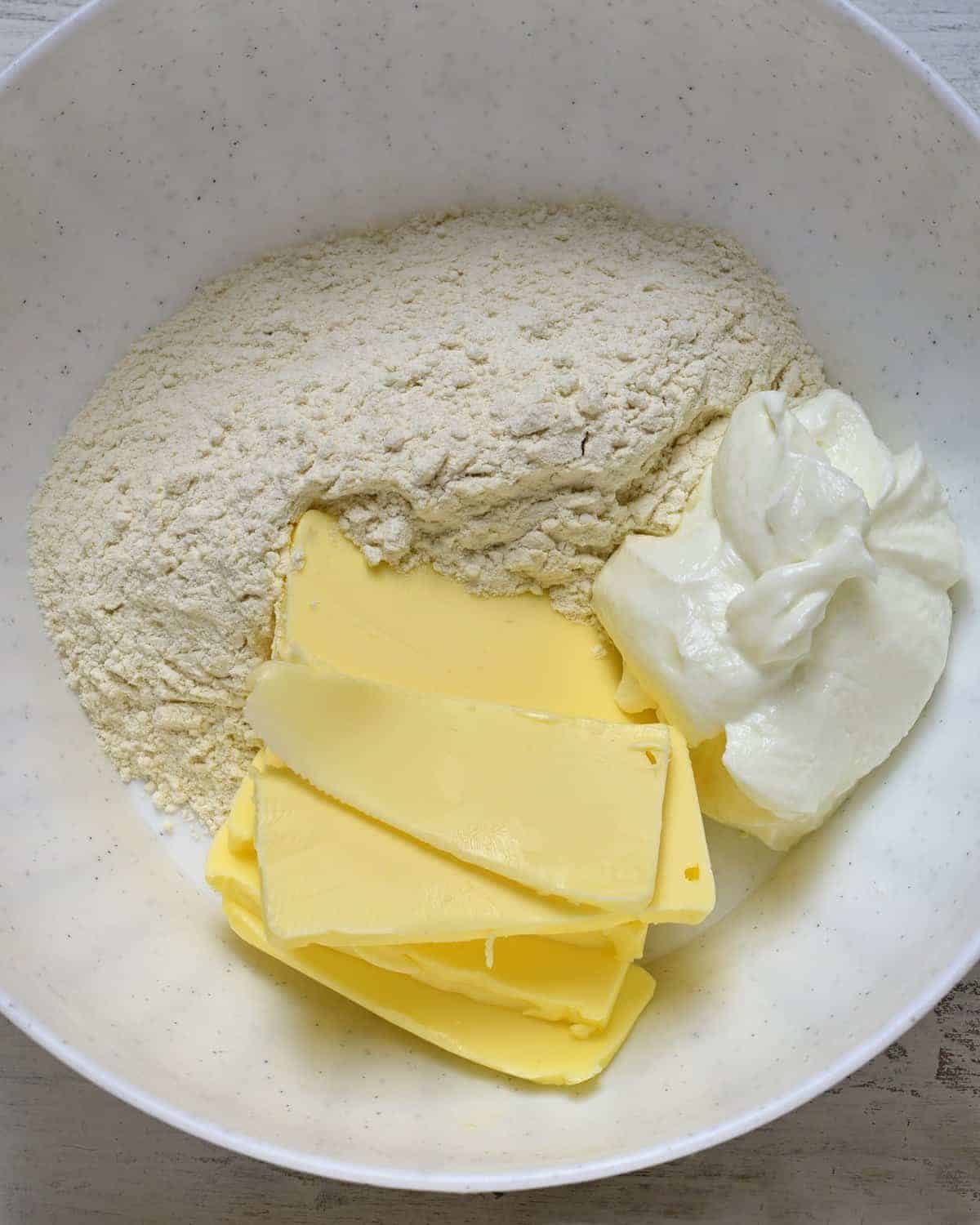
STEP 3: Wrap the dough in cling film and place in the freezer (not the fridge) for 10-15 minutes, but not any longer.
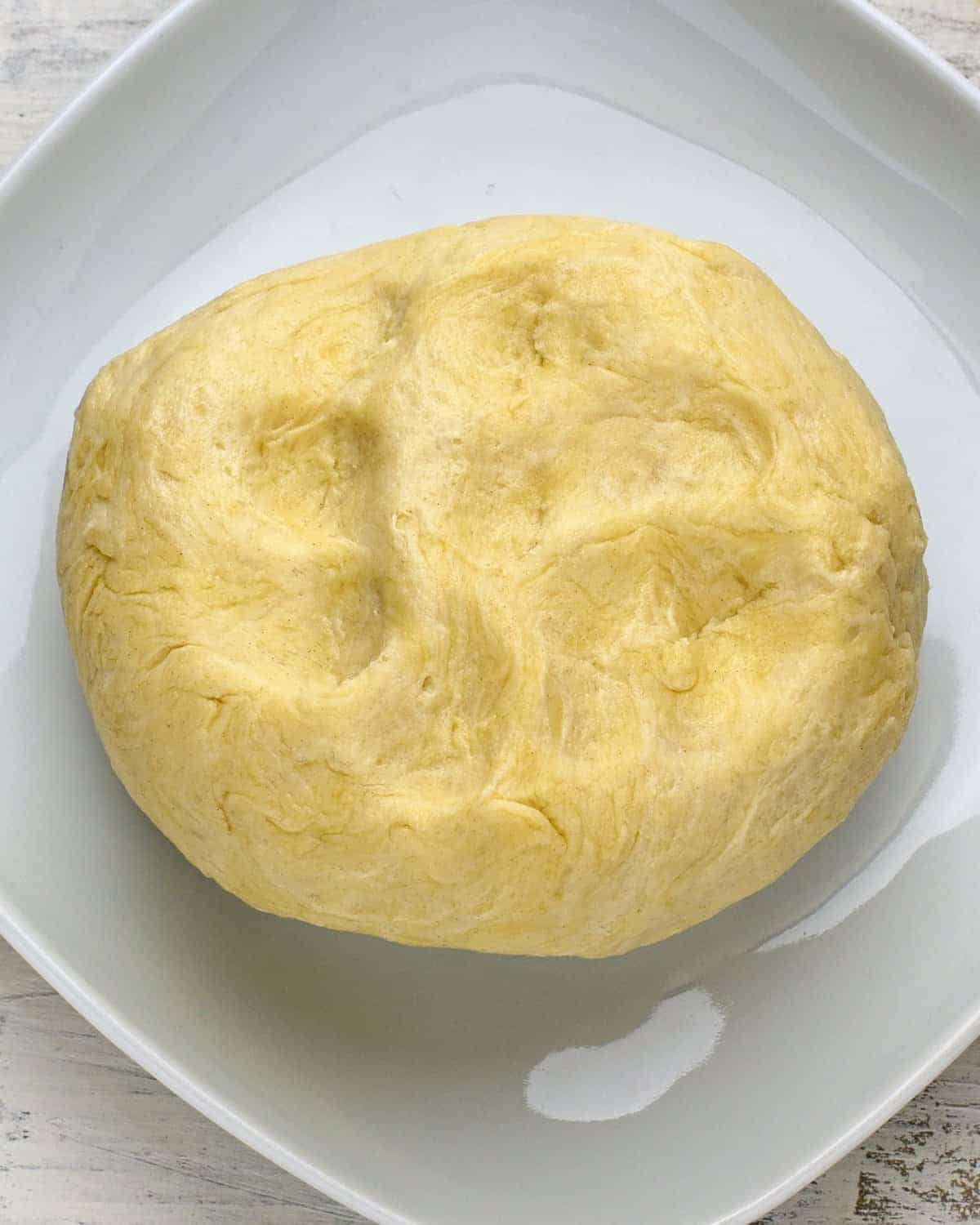
STEP 4: Lightly dust the work surface with flour to prevent the dough from sticking to it. Roll the dough into as regular a rectangle as possible, which should be 1/8 inch thick.
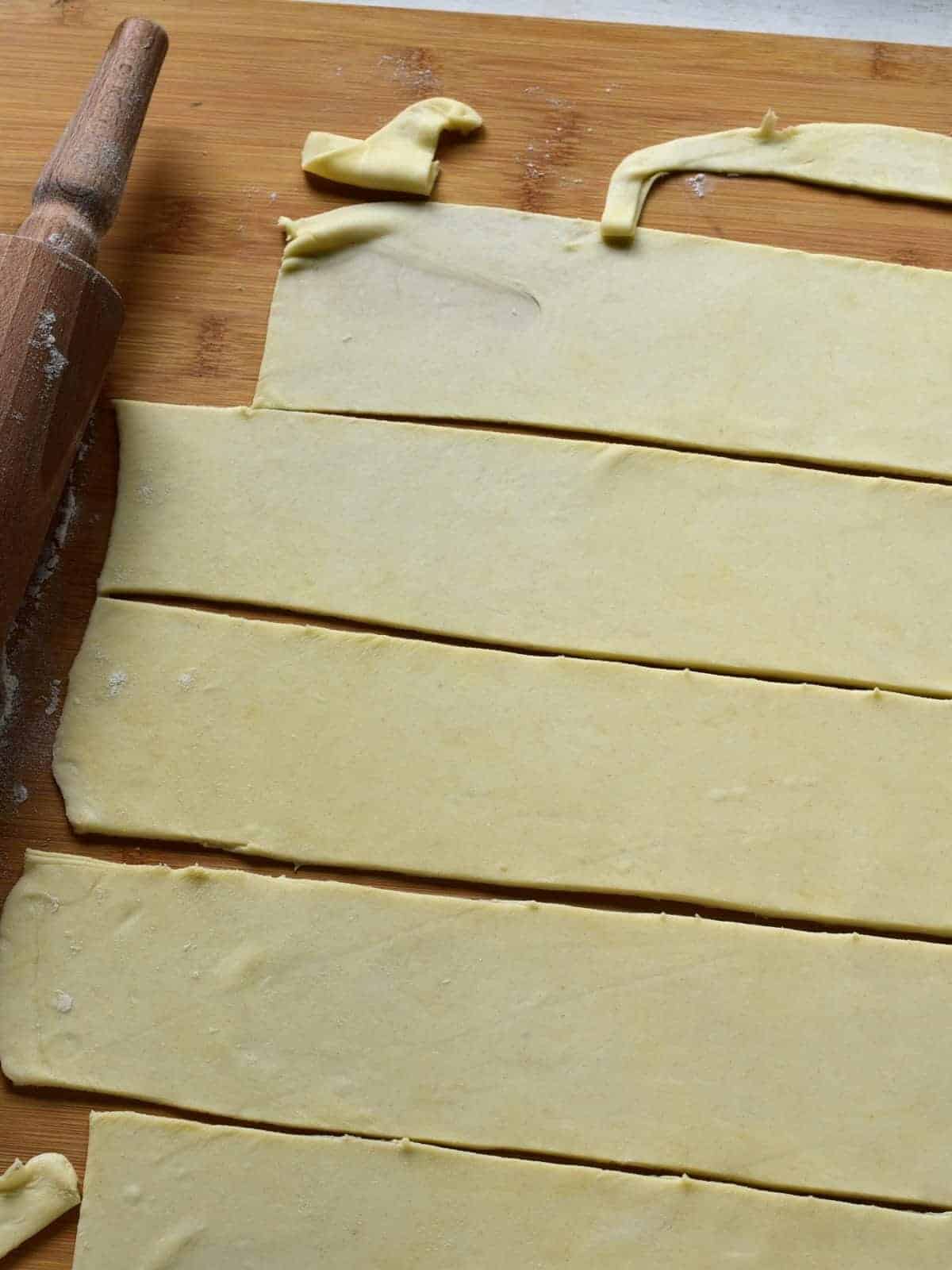
STEP 5: Cut the rolled-out dough into squares of approximately 2.1/2 inches. Place about 1 to 1.1/2 teaspoons of jam in the middle of each square.
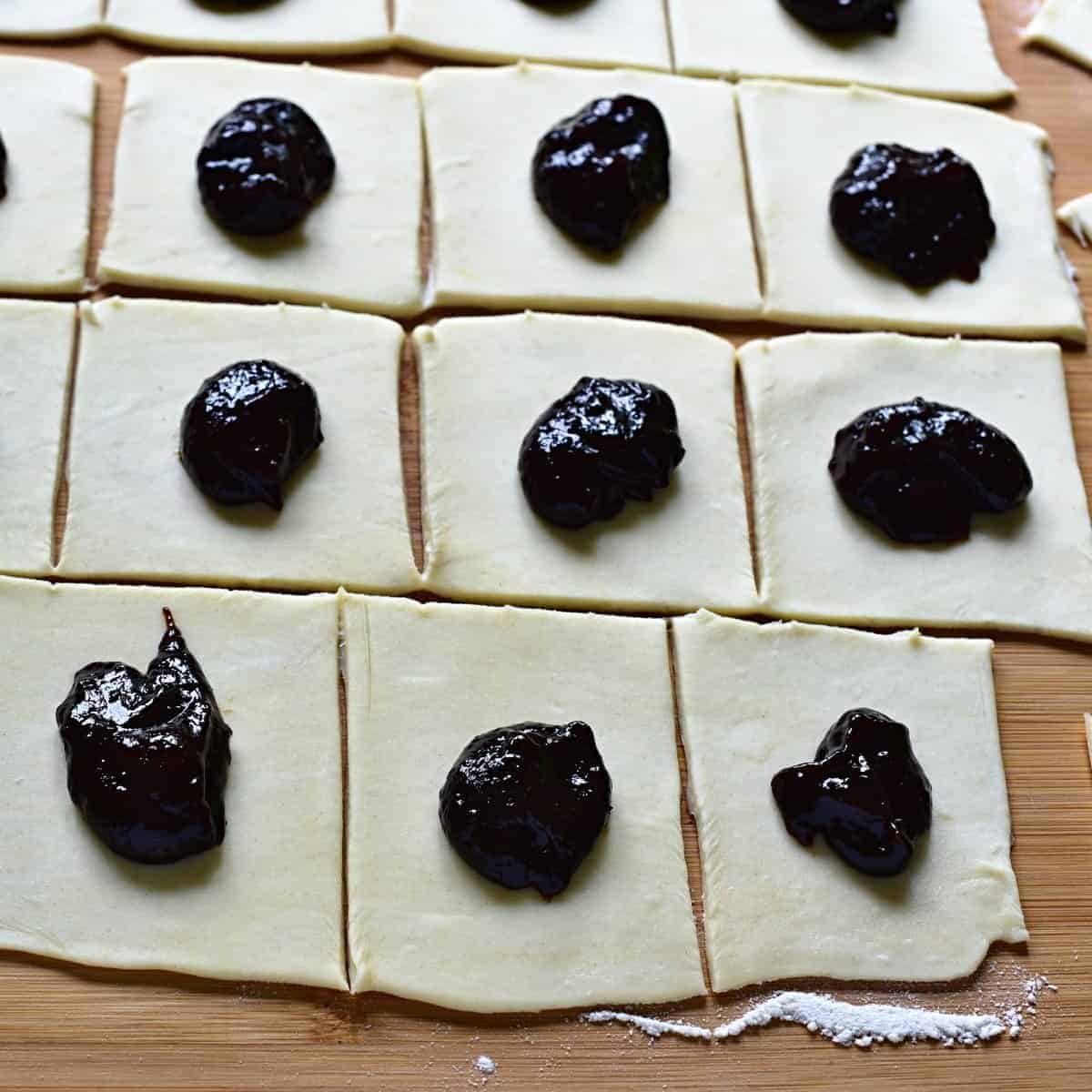
STEP 6: Using a kitchen knife, lift opposite ends of the dough and fold them one by one over the filling. Finally, press the folded ends of the dough lightly together.
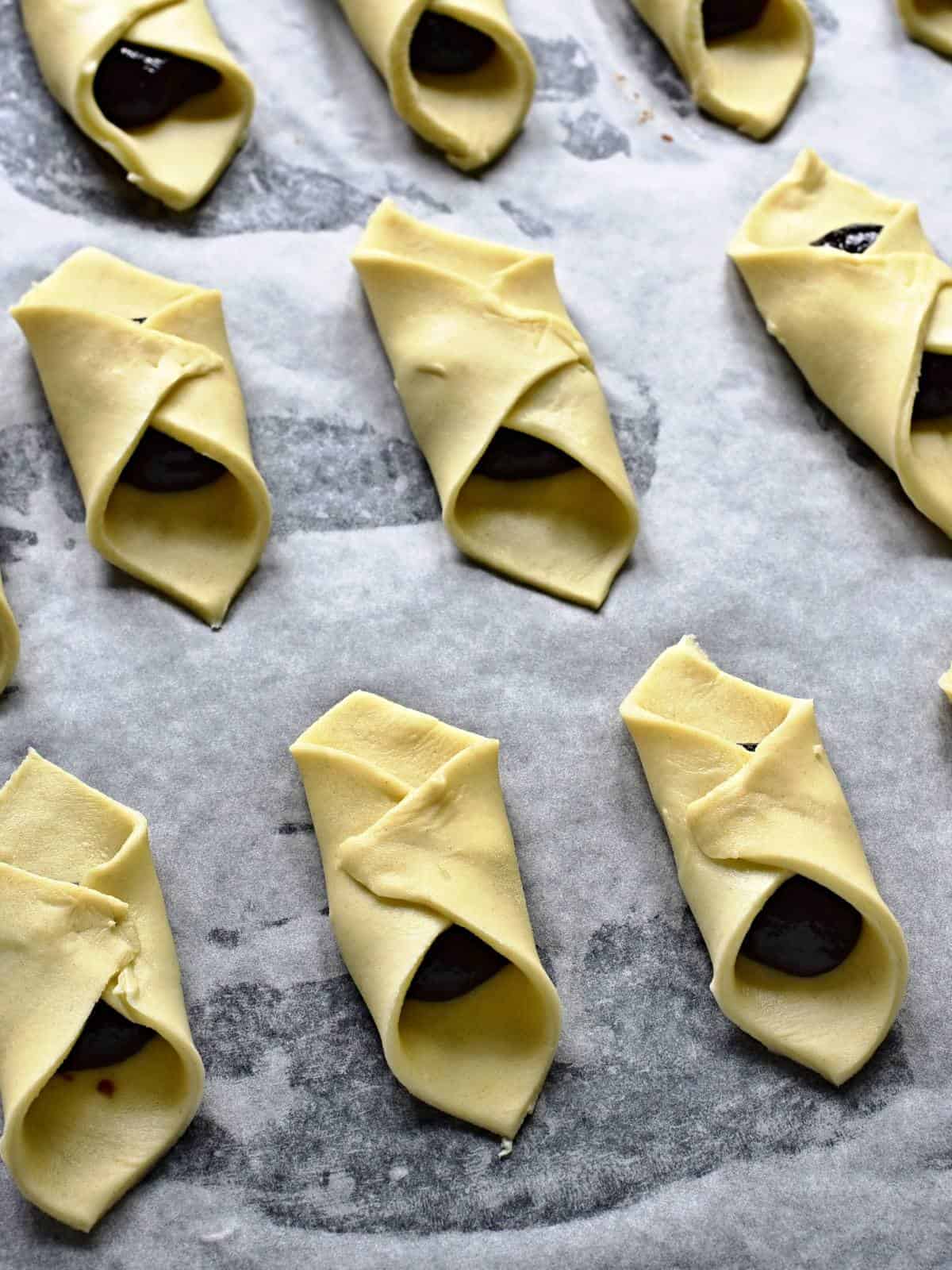
STEP 7: Carefully transfer kolacky cookies to a baking sheet lined with baking paper.
STEP 8: Preheat the oven to 340 °F (170 °C). Place the baking sheet with kolacky in the preheated oven and bake for about 15 minutes until golden.

STEP 9: Immediately after baking, dust with icing sugar and leave to cool.
Serving
Kolacky cookies taste best while still warm. Serve on a dessert plate with a cup of good coffee or tea.
The next day kolacky are softer and less flaky than when fresh straight out of the oven.
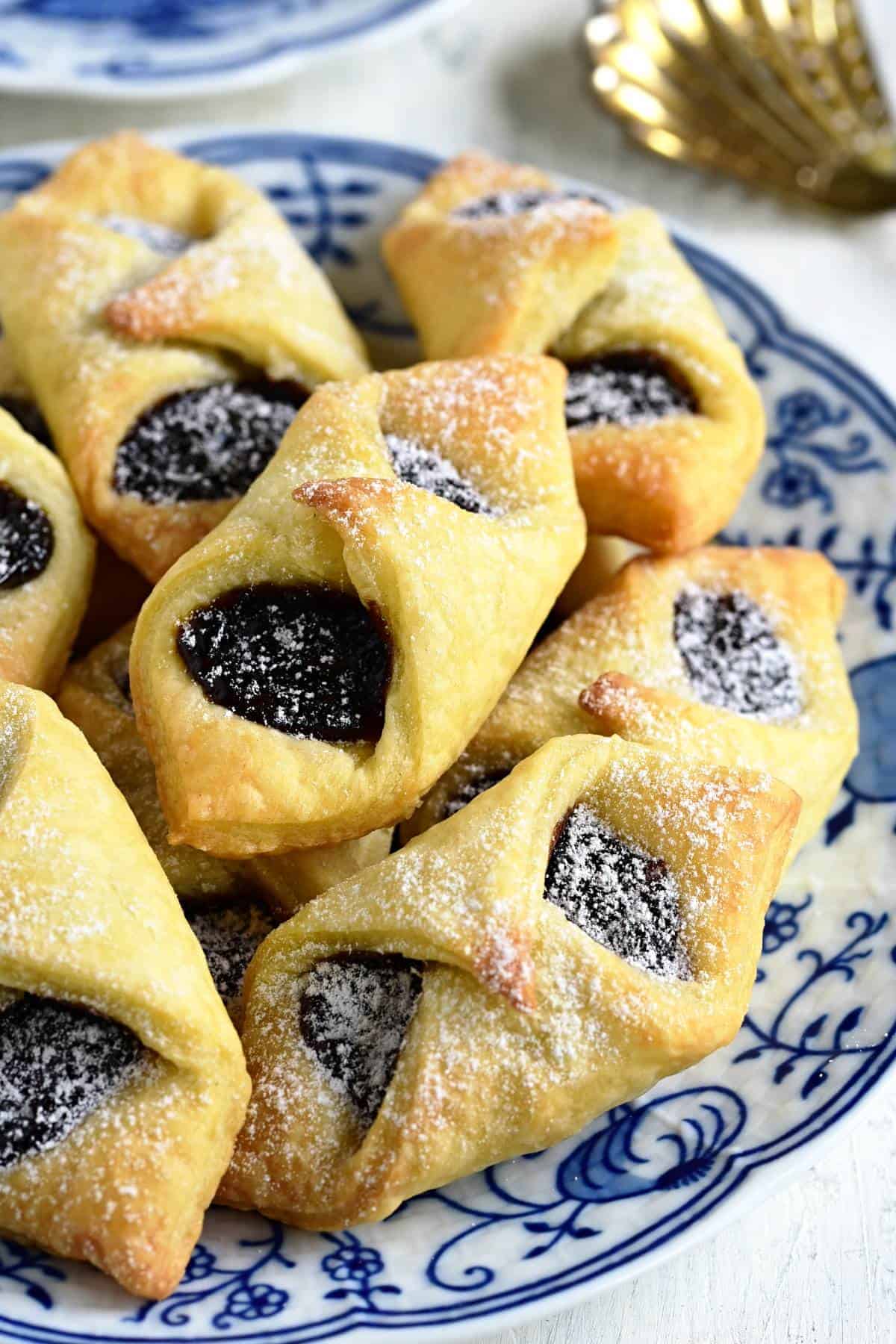
Tips for The Best Result
- When rolling out the dough, sprinkle it with flour. Also, press your hand into the flour and run it over the rolling pin you will use to roll out the dough. Yet, the finished dough should be still slightly sticky.
- You can also shape the cookies by cutting circles about 2 inches in diameter out of the dough. Place a teaspoon of filling in the middle, fold the circle in half over the filling, and close the ends with a fork to keep the filling from oozing out. Take a look at these crescent cookies to see the process.
More sweets:
- Moravian kolache – double filled sweet pastry
- Cream cheese coffee cake – with fruit
- Bublanina – Czech fruit sheet cake
FAQ
The base for kolacky is a dough in the shape of a square about 2 1/2 inches large. A filling, usually jam, is placed in the middle of the square. Kolacky are shaped by folding the two opposite ends of the square over the filling one at a time. The dough is lightly pinched together at the joint.
Try to leave the dough slightly sticky, do not sprinkle it with excessive flour when rolling it out. This will seal the dough when it joins over the filling and prevent it from opening when baking.
Another option is to brush the place where the dough ends join with a little beaten egg.
If you have any kolacky leftovers, let them cool completely and store them in an airtight container. Store in the fridge, where they will keep for about four days. You can also freeze the kolacky cookies. They will keep in the freezer for up to 6 months in an airtight container.
Recipe card
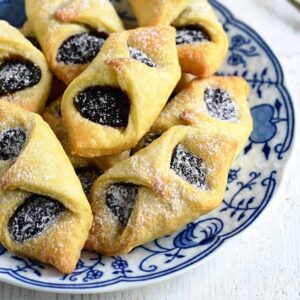
Easy Kolacky Cookies
Ingredients
Cream cheese dough:
- 1 Stick unsalted butter (110 g) at room temperature
- 4 ounces cream cheese (110 g) at room temperature
- 1 and ¼ cups all-purpose flour (160 g)
Filling:
- ⅔ cup pastry fruit filling (220 g)
Misc.
- 2 Tablespoons powdered sugar for icing
Instructions
- Take the butter and cream cheese out of the refrigerator in time for them to come to room temperature.
- Put the butter, cream cheese, and flour in a larger bowl. Start mixing the ingredients with a fork first. Only when the dough has come together in a homogeneous mass, knead the dough smooth with your hands.
- Wrap the dough in cling film and place in the freezer (not the fridge) for 10-15 minutes, but no longer.
- Lightly dust the work surface with flour to prevent the dough from sticking to it. Roll the dough into as regular a rectangle as possible to a thickness of ⅛ inch.
- Cut the rolled-out dough into squares of approximately 2.½ inches. Place about 1 to 1.½ teaspoons of jam in the middle of each square.
- Using a kitchen knife, lift opposite ends of the dough and fold them one by one over the filling. Finally, press the folded ends of the dough lightly together.
- Carefully transfer kolacky cookies to a baking sheet lined with baking paper.
- Preheat the oven to 340 °F (170 °C). Place the baking sheet with kolacky in the preheated oven and bake for about 15 minutes until golden.
- Immediately after baking, dust with icing sugar and leave to cool.
Notes
- Makes about 20 kolacky cookies.
- SERVING: Kolacky cookies taste best while still warm. Serve on a dessert plate with a cup of good coffee or tea. The next day kolacky are softer and less flaky than when freshly coming out of the oven.
- When rolling out the dough, sprinkle it with flour. Also, press your hand into the flour and run it over the rolling pin you will use to roll out the dough. Yet, the finished dough should be slightly sticky.
- STORAGE: If you have any kolacky leftovers, let them cool completely and store them in an airtight container. Store in the fridge, where they will keep for about four days. You can also freeze the kolacky cookies. They will keep in the freezer for up to 6 months in an airtight container.
DISCLAIMER: Because I come from Central Europe, my recipes are based on metric units such as grams or milliliters. Check out how I convert metric units to the U.S. system:
Conversion chart

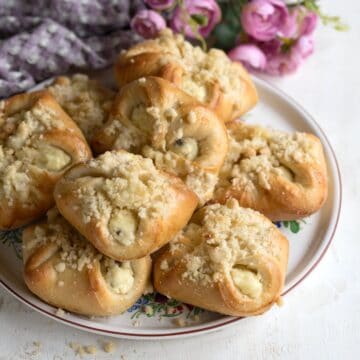
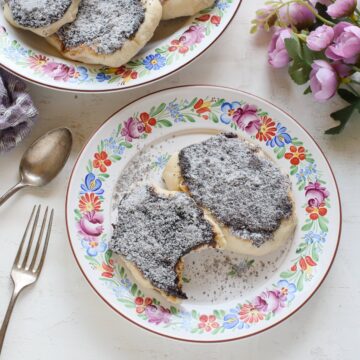
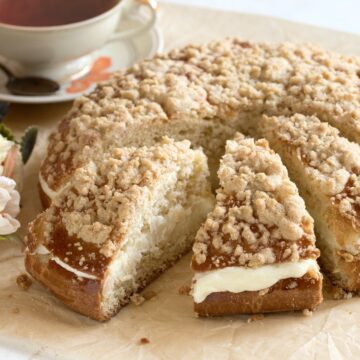
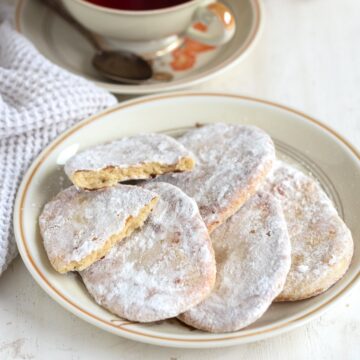
Mary Ray
Hello again Petra! After such wonderful success with your cucumber salad recipe, I began looking at your other recipes. I cannot believe I have been using this same Kolacky recipe for my whole life! My german mother learned it from my father's mother (from Chicago but of German descent). My mother made them every Christmas, and I have made them every Christmas....my 3 young adult daughters insist on it!! The dough is so tender and flake and melt-in- your mouth. My favorite filling was also a plum filling.... but I have not seen it in stores for a number of years????). I make my dough with cold cheese and butter and I just pulse it in my food processor and then like you said I kind of form it together with my hands, trying not to work it too much so it stays tender. I was taught to cut it in circles and just place a dollop of the filling in the middle... no folding. This is definitely a winning recipe!!
(Have you ever tried a recipe called "schokoladenbrot" from across the border in Bavaria? It is the other recipe I "must" make for my daughters ????)
Mary Ray
I wonder if I have been pronouncing "kolacky" correctly, or incorrectly my whole life???????
Petra Kupská
???? I will ask my son to lend me a microphone this afternoon and record how kolacky are pronounced in Czech. I'll post the audio clip here with the recipe.
Kolacky is a typical original Czech word, but I understand it is pronounced differently in various parts of the world.
Bev Sebek
Hello Petra, I have been searching for the recipe for a veal and pork dish that would be similar to the texture of stuffing that my Grandmother and my Mom would make at Easter. Garlic was one of the seasonings. Do you know of this? my spelling of it will be how it sounds...itenyitze...sorry I don't know the czech spelling.
Anicka Cooklikeczechs.com
Hello, thank you for your comment. I believe you mean a "jiternice" or "jaternice". It is a stuffed casing with a mixture of pork and spices. The recipe for jitrnice is not yet on the web, unfortunately, but you can be sure it is on the to-do list 🙂
Petra Kupská
Ahoj Mary, as promised, I recorded a short audio clip with the Czech pronunciation of kolacky (koláčky). You can find the audio file at the top of the recipe under "Spelling". I'm curious if you pronounce this word kolacky the same way 🙂
Petra Kupská
Thank you for the detailed comment on the "kolacky recipe" 🙂
I think the kolacky dough is very popular all over Central Europe, and not only here, probably in other parts of the world as well.
As with all rolled-out doughs, the most important thing is to get the ratio of ingredients right so that the dough is not too stiff but not sticky either.
In addition, the main ingredient in the recipe is the Czech "tvaroh" (Quark or Topfen in German), and this cream cheese can have different consistencies. Then you have to estimate how much flour will go into the dough. But I really enjoy baking this 🙂
I'm surprised that you can't buy plum marmalade in the US, in the Czech Republic, it's in every store.
As for the shape of the cookies, we also sometimes make them round (not a rolled-out square and folding the ends of the dough over the filling). Then we sprinkle Streusel topping (Czech "drobenka") on top of the kolacky cookies.
Schokoladenbrot - I'm not familiar with this, I just looked it up on the internet and it looks like a great sheet cake covered with chocolate 🙂
Helen Burich
I have not made these yet, but I make mine with ice cream. Have you ever done them this way?
Petra Kupská
Thank you for your comment; kolacky with ice cream, that's an interesting new thing for me. Would you please give me a short description of your recipe?
Elizabeth
can I freeze the dough before assembling them and take it out the night before and refrigerate to thaw to make the next day
Beverly
Love her recipes
Vicki
My grandma used a crushed pineapple and walnut filling. It was delicious ????
Petra Kupská
Oh, thank you for the kolacky filling tips! Walnut filling is also common in the Czech Republic, and I really like that too. Poppyseed or dried pear filling is also used. However, crushed pineapple is new to me; I honestly don't know that one 🙂
Julia
Poppyseed was always my favorite. My daughter did a great job on theres. Definitely trying this recipe. TY.
Petra Kupská
Yes, poppyseed is also an excellent filling for kolacky, a great choice! 🙂
Barbara
Almond is my family's favorite!
Petra Kupská
I love almond filling too, in fact any nuts!
Amanda
What would the recipe be for the walnut filling? My husbands family said they used to love the walnut filling ones. I want to make some for them, but I’m just not sure how to make the filling.
Petra Kupská
Walnut filling is an excellent idea for these kolacky cookies! There are more ways to prepare the walnut filling. I'll look for a proven recipe and post it here soon.
Eva
I’ve been doing this recipe my whole life my mom used to call
”Křupinky”
My family loved them specially grandchildren.
My grandson came visit me in Florida
His first question was please can you make me křupinky please ?
I made a double amount it was gone in one day
Petra Kupská
Thank you for your kind comment, "křupinky" is a lovely Czech word; it actually expresses how crispy and fluffy these cookies are. And I believe your grandson loves them, especially when his beloved Grandma bakes them! In our house, too, one batch is usually not enough.
Beata
This recipe is wonderful. It was my first time making kolaczki, but definitely not the last. The recipe was easy to follow and they came out great. My whole family loved them. Thank you, Petra!
Petra Kupská
Ahoj Beata, thank you very much for your lovely comment. I am happy to hear this; kolacky is always a hit in our family! 🙂
Zach
These cookies are amazing! I have limited baking experience and have never made kolacky before. But the recipe was simple and easy to follow, so they turned out great! We made them with Raspberry filling, but are excited to try different flavors and filling options in the future.
Thanks so much for sharing this recipe, Petra!
Petra Kupská
Happy to hear this! Thank you for your lovely feedback 😊
Sharon
What do u mean by scooping out opposite ends of the dough???
Petra Kupská
A better word than "scoop out" is probably "lift." It means to lift the ends of the dough (preferably with a knife) and fold them over the cookie filling. I edited the word in the recipe to avoid any confusion.
Cherry Chapman
Hi Petra!,
I made these delicious Kolacky pastries this weekend and they were divine! I loved that the dough was not sweet which provide a lovely contrast to the sweet filling.
I did not find quark here in Paris, but used the French equivalent of cream cheese, "fromage à tartiner".
I made my own poppy seed filling, but I can see that a dried apricot, honey and walnut filling would be great too.
Thank you so much Petra for publishing this wonderful recipe!
I definitely want to make then again!
Anicka Cooklikeczechs.com
Ahoj Cherry, thank you for your comment and feedback! I am so happy the recipe was a success! Lots of luck on your next baking projects!
jess
Oh yay! My grandmother used to make these. I loved the poppy seed (poppa seed was how she said it. Always makes me smile. Can't wait to try your recipe!
Petra Kupská
That is nice! I once read someone called them puppy seed kolacky 🙂 Wishing you success with the baking!
Victoria
I made these for my mother-in-law who has been trying to find a kolacky like the ones she used to get in Chicago. She said they were “perfect.” I used raspberry and apricot preserves because that was all that was available. I would love to make these with plum butter. Would you have a recipe for that? I haven’t been able to find one that looks like it would work. Also, I want to let you know that I have made all your bread recipes and all are wonderful. We especially like the rye bread and rolls. Thank you.
Anicka Cooklikeczechs.com
Dear Victoria, thank you for your comment!
Plum butter (in Czech povidla) is made from overripe plums that are cooked long and slow in a pot until most of the liquid has evaporated. I know they are not so easy to obtain abroad. Plum butter commonly sold in stores tend to be more of a liquid consistency or contain a lot of sugar. The sugar will cause the plum filling to leak out of the kolace. If you would like plum butter for filling baked cookies, I recommend checking to see if you have a European Deli near you. This is where you can get Polish or German plum butter (powidl), which should work well.
Many greetings from the Czech Republic!
Kayleen
I always knew these as kolache. My grandparents were Czech. My great-grandparents immigrated to United States (Ultimately to Minnesota) in late 1890s to early 1900s. The Czech accent was strong in my grandfather. When my grandparents passed, we had to find a Czech person to make these to serve at the funeral. I never knew this recipe was so easy. I never saw my grandmother bake these. I think they made them at the community senior center often and had them frozen as needed. I will have to give these a try.